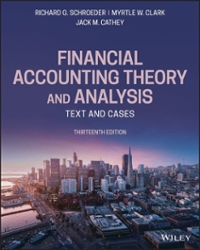Question
MULTIPLE CHOICE 1.The transaction approach to determining income is a concept in which a. income is measured as the amount that an entity could consume
MULTIPLE CHOICE
1.The transaction approach to determining income is a concept in which a. income is measured as the amount that an entity could consume during a period and be as well off at the end of that period as it was at the beginning. b. the financial statement effects of business events are classified as revenues, gains, expenses, and losses, which are used to measure and define income. c. market values adjusted for the effects of inflation or deflation are used to calculate income. d. income equals the change in market value of the firm's outstanding common stock for the period.
2.Financial statement elements relating to income are defined in FASB Concepts Statement 6 as follows: a. Gains are increases in equity from ongoing major or central operations of an entity. b. Expenses are outflows of assets or liabilities incurred from peripheral or incidental transactions of an entity. c. Revenues are inflows or other enhancements of assets or settlements of liabilities from ongoing major or central operations. d. Losses are all decreases in equity other than from transactions with owners.
3.On a multiple-step income statement, gains or losses on sale of equipment would be shown a. before gross profit on sales. b. after gross profit on sales but before income from continuing operations. c. after income from continuing operations but before income from extraordinary items. d. after income before extraordinary items but before net income.
4.A material loss should be presented separately as a component of income from continuing operations when it is a. infrequent in occurrence but not unusual in nature. b. infrequent in occurrence and unusual in nature. c. a cumulative effect-type change in accounting principle. d. an extraordinary item.
5.The normal ordering of items in the income statement would be best illustrated by which of the following? a. Extraordinary items, cumulative effects, income from continuing operations, discontinued operations, net income b. Income from continuing operations, discontinued operations, extraordinary items, cumulative effects, net income c. Income from continuing operations, extraordinary items, cumulative effects, discontinued operations, net income d. Discontinued operations, income from continuing operations, extraordinary items, cumulative effects, net income
6.A single-step income statement is a format that a. compares the current year's income with last year's income. b. recognizes subtotals at intermediate stages such as gross margin. c. combines revenues and gains and subtracts from them expenses and losses, resulting in income from operations. d. reports sales revenue, cost of goods sold, gross margin, and all other expenses.
7.An earthquake destroyed the home office building of a company located in an inland city. This should be reported as a(n) a. extraordinary loss. b. prior period adjustment. c. loss from continuing operations. d. loss from discontinued operations.
8.When a business segment is discontinued during the year, the gain or loss on disposal a. is reported as an extraordinary item. b. should include only the loss or income from operating the discontinued segment for the current period. c. excludes only the gain or loss on disposal of the segment. d. should be shown net of applicable income taxes.
9.Which of the following most likely would be considered a discontinued operation? a. Production or marketing functions are shifted from one location to another. b. A sporting goods manufacturer has a bicycle division that meets FASB's definition of a component of the entity and decides to outsource the manufacture of its bicycles. c. The unprofitable brands of a beauty products component of an entity that manufactures and sells consumer products are discontinued. d. An entity that is a franchiser in the quick-service restaurant business also operates company-owned restaurants that are unprofitable in a certain region and, as a result, the entity decides to exit both the quick-service business as well as the company-owned restaurants in that region.
10.Costs that can be reasonably associated with specific revenues but NOT with specific products should be a. charged to expense in the period incurred. b. allocated to specific products based on the best estimate of the production processing time. c. expensed in the period in which the related revenue is recognized. d. capitalized and then amortized over a period not to exceed 60 months.
Step by Step Solution
There are 3 Steps involved in it
Step: 1

Get Instant Access to Expert-Tailored Solutions
See step-by-step solutions with expert insights and AI powered tools for academic success
Step: 2

Step: 3

Ace Your Homework with AI
Get the answers you need in no time with our AI-driven, step-by-step assistance
Get Started


